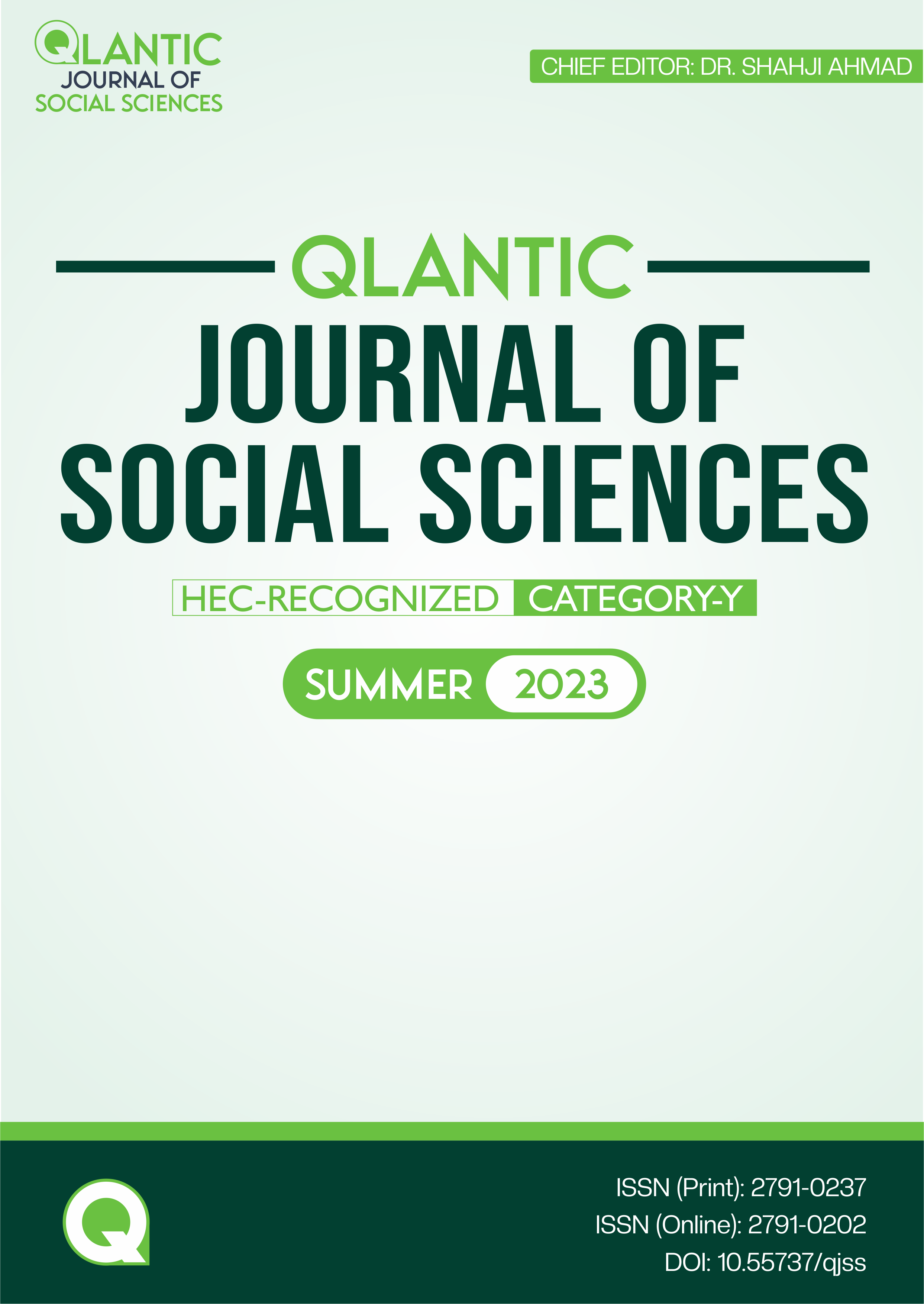Historical Behavior Regarding Infectious Diseases and Natural Disasters
DOI:
https://doi.org/10.55737/qjss.202834437Keywords:
Disasters, , Infectious Diseases (I.D.s), Mental Disorders, Human BehaviorAbstract
Disaster affects ecological value and human presence. Only then will it be considered a disaster. Weather, climatic conditions, quality of air, drinking water and unhealthy lifestyles add to the adversity of disaster. Its spread can be sudden, frequent or non-frequent in local, national, multinational or global communities for a short or long period of time. Disasters can be classified into two major categories: natural and human–made disasters. The psychological effects of the disaster are much more than the actual medical condition because the victims keep on re-enchanting the scenes of chaos in their minds and react according to their resilience.
References
Afifi, M. M. (2007). Gender differences in mental health. Singapore Medical Journal, 48(5), 385-391. https://www.researchgate.net/profile/Mustafa-Afifi-4/publication/6376128_Gender_differences_in_mental_health/links/0046352aebddcad44f000000/Gender-differences-in-mental-health.pdf
Allinson, R. E. (1993). Classic Cases - GLOBAL DISASTERS: Inquiries into Management Ethics. New York: Prentice Hall.
Bharti, N. (2021). Linking human behaviors and infectious diseases. Proceedings of the National Academy of Sciences, 118(11), e2101345118. https://doi.org/10.1073/pnas.2101345118
Birkland, T. (1997). After Disaster: Agenda Setting, Public Policy, and Focusing Events. Washington, DC.: Georgetown University Press.
Bonanno, G. A., Brewin, C. R., Kaniasty, K., & Greca, A. M. L. (2010). Weighing the Costs of Disaster. Psychological Science in the Public Interest, 11(1), 1–49. https://doi.org/10.1177/1529100610387086
Bourdelais, P. (2021). The COVID-19 Pandemic in Historical Perspective. Historical Social Research / Historische Sozialforschung. Supplement, 33, 302–315. https://www.jstor.org/stable/27087285
Burnett, K., Ironson, G., Benight, C., Wynings, C., Greenwood, D., Carver, C. S., Cruess, D., Baum, A., & Schneiderman, N. (1997). Measurement of perceived disruption during rebuilding following Hurricane Andrew. Journal of Traumatic Stress, 10(4), 673-681. https://doi.org/10.1002/jts.2490100413
Cohen, R., C. (1987). Human Problems in Major Disasters: A Training Curriculum for Emergency Medical Personnel. Washington, DC: U.S. Government Printing Office.
Dege, M., & Strasser, I. (2022). Global Pandemics and Epistemic Crises in Psychology: A Socio-Philosophical Approach. New York: Routledge.
Fauci, A. S. (2017). Three Decades of Responding to Infectious Disease Outbreaks. https://www.niaid.nih.gov/news-events/three-decades-responding-infectious-disease-outbreaks
Funk, S., Salathé, M., & Jansen, V. A. A. (2010). Modelling the influence of human behaviour on the spread of infectious diseases: a review. Journal of the Royal Society Interface, 7(50), 1247–1256. https://doi.org/10.1098/rsif.2010.0142
Green, B. L. (1990). Defining Trauma: Terminology and Generic Stressor Dimensions1. Journal of Applied Social Psychology, 20(20), 1632–1642. https://doi.org/10.1111/j.1559-1816.1990.tb01498.x
Green, B. L., Korol, M., Grace, M. C., Vary, M. G., Leonard, A. C., Gleser, G. C., & Smitson-cohen, S. (1991). Children and Disaster: Age, Gender, and Parental Effects on PTSD Symptoms. Journal of the American Academy of Child & Adolescent Psychiatry, 30(6), 945–951. https://doi.org/10.1097/00004583-199111000-00012
Hays, J. N. (2005). Epidemics and pandemics: their impacts on human history. California: ABC-CLIO, Inc.
Kholodkov, T., Short, A., & Chrisman, A. K. (n.d.). Mental Health in Disaster: Issues and Intervention. Eastern AHEC: https://www.aacap.org/App_Themes/AACAP/Docs/resource_centers/disaster/resource_group/presentations/Mental-Health-in-Disaster.pdf
López, -Ibor Jr., J. J., Christodoulou, G., Maj, M., Sartorius, N., & Okasha, A. (2005). Disasters and Mental Health. USA: Wiley.
Mathúna, D. P., & Dranseika, V. (2018). Disasters: Core Concepts. USA: Springer Open.
McFarlane, A. C. (1989). The Aetiology of Post-traumatic Morbidity: Predisposing, Precipitating and Perpetuating Factors. British Journal of Psychiatry, 154(2), 221–228. https://doi.org/10.1192/bjp.154.2.221
National Academy of Sciences. (2001). Health and Behavior: The Interplay of Biological, Behavioral, and Societal Influences. Washington, D.C.: Institute of Medicine, National Academy Press. https://doi.org/10.17226/9838
O’Reilly, N. (2016). Disaster Management. Physiopedia. https://www.physio-pedia.com/Disaster_Management
Qiu, W., Rutherford, S., Mao, A., & Chu, C. (2017). The pandemic and its impacts. Health, Culture and Society, 9, 1-11. https://doi.org/10.5195/hcs.2017.221
Quarantelli, E. (1998). What is a Disaster?A Dozen Perspectives on the Question. London: Routledge.
Quinlan, H. (2020). Plagues, Pandemics and Viruses: From the Plague of Athens to Covid-19. Visible Ink Press.
Rittershaus, L., & Eschenberg, K. (2021). Black Death, Plagues, and the Danse Macabre. Depictions of Epidemics in Art. Historical Social Research / Historische Sozialforschung. Supplement, 33, 330–341. https://www.jstor.org/stable/27087287
Schaller, M. (2021). Speaking of Psychology: How the threat of disease has shaped human behavior. (K. Mills, Interviewer) American Psychological Association: https://www.apa.org/research/action/speaking-of-psychology/threat-disease
Shaw‐Taylor, L. (2020). An introduction to the history of infectious diseases, epidemics and the early phases of the long‐run decline in mortality. The Economic History Review, 73(3), E1–E19. https://doi.org/10.1111/ehr.13019
Sheik, K. (2018). Natural Disasters Take a Toll on Mental Health https://www.brainfacts.org/Diseases-and-Disorders/Mental-Health/2018/Natural-Disasters-Take-a-Toll-on-Mental-Health-062818
Stasha, S. (2021). Natural Disaster Statistics — The U.S. and the World. PolicyAdvice. https://policyadvice.net/insurance/insights/natural-disaster-statistics/
Tan, M. M., Musa, A. F., & Su, T. T. (2021). The role of religion in mitigating the COVID-19 pandemic: the Malaysian multi-faith perspectives. Health Promotion International, 37(1). https://doi.org/10.1093/heapro/daab041
Taylor, S. (2019). The Psychology ofPandemics: Preparing for the Next Global Outbreak of Infectious Disease. U.K.: Cambridge Scholars Publishing.
Thucydides. (2017). History of the Peloponnesian War, Book 2, Chapter VII, trans. Crawley R. Digireads.com
Ting, R. S.-K., Aw Yong, Y.-Y., Tan, M.-M., & Yap, C.-K. (2021). Cultural Responses to Covid-19 Pandemic: Religions, Illness Perception, and Perceived Stress. Frontiers in Psychology, 12. https://doi.org/10.3389/fpsyg.2021.634863
UN. (1992). Internationally Agreed Glossary of Basic Terms Related to Disaster Management. Geneva : U.N. Department of Humanitarian Affairs.
Ursano, R. J., McCaughey, B. G., & Fullerton, C. S. (1994). Community responses to disaster: the Gander plane crash. In Wright, & P. B. K.M., Individual and Community Responses to Trauma and Disaster: the structure of human chaos (pp. 267-284). Cambridge: Cambridge University Press.
Washer, P. (2010). Emerging Infectious Diseases and Society. New York: Palgrave Macmillan.
Westlake, H. (. (2018). Haiti Earthquake. Natural Disasters, pp. 10-13.
What is a disaster? (2021). International Federation of Red Cross and Red Crescent Societies: https://www.ifrc.org/what-disaster
WHO. (1991). Psychosocial Consequences of Disasters – Prevention and Management. Geneva: World Health Organization, https://apps.who.int/iris/bitstream/handle/10665/58986/WHO_MNH_PSF_91.3_REV.1.pdf?sequence=1&isAllowed=y
Witt, J. F. (2020). American Contigons Epidemics and the Law: from Smallpox to Covid-19. Yale University Press.
World Health Organization. (2022, June 8). Mental disorders. World Health Organization. https://www.who.int/news-room/fact-sheets/detail/mental-disorders




